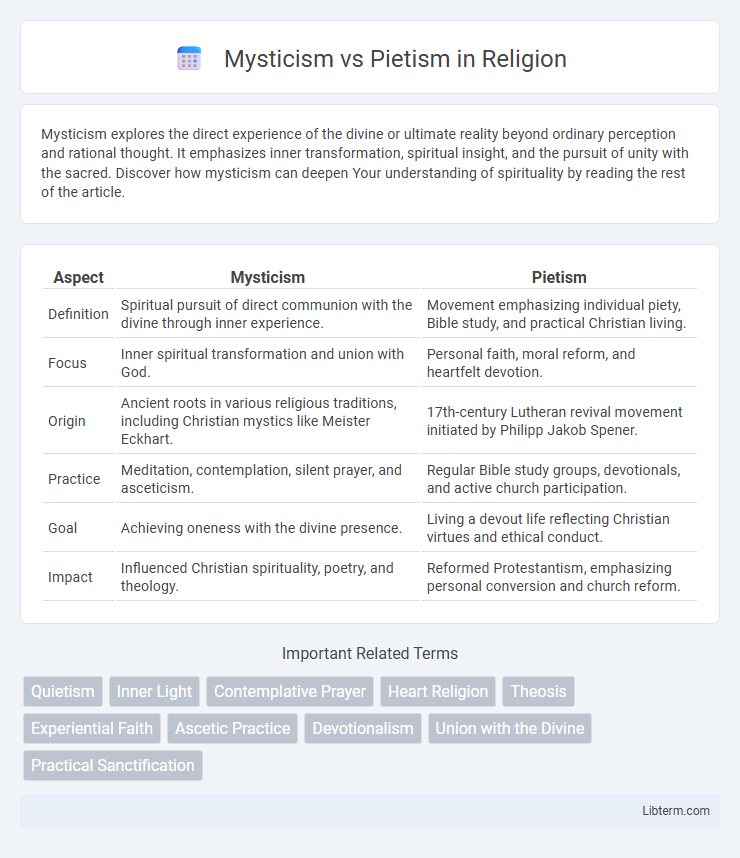Mysticism explores the direct experience of the divine or ultimate reality beyond ordinary perception and rational thought. It emphasizes inner transformation, spiritual insight, and the pursuit of unity with the sacred. Discover how mysticism can deepen Your understanding of spirituality by reading the rest of the article.
Table of Comparison
| Aspect | Mysticism | Pietism |
|---|---|---|
| Definition | Spiritual pursuit of direct communion with the divine through inner experience. | Movement emphasizing individual piety, Bible study, and practical Christian living. |
| Focus | Inner spiritual transformation and union with God. | Personal faith, moral reform, and heartfelt devotion. |
| Origin | Ancient roots in various religious traditions, including Christian mystics like Meister Eckhart. | 17th-century Lutheran revival movement initiated by Philipp Jakob Spener. |
| Practice | Meditation, contemplation, silent prayer, and asceticism. | Regular Bible study groups, devotionals, and active church participation. |
| Goal | Achieving oneness with the divine presence. | Living a devout life reflecting Christian virtues and ethical conduct. |
| Impact | Influenced Christian spirituality, poetry, and theology. | Reformed Protestantism, emphasizing personal conversion and church reform. |
Defining Mysticism and Pietism
Mysticism centers on the direct, personal experience of the divine, emphasizing inner spiritual transformation and union with God through contemplation and prayer. Pietism, emerging in the 17th century, advocates for heartfelt devotion, practical Christian living, and moral reform within the church community. Both movements prioritize spirituality but differ in approach: mysticism leans toward individual experiential knowledge, while pietism stresses communal piety and ethical conduct.
Historical Origins of Mysticism and Pietism
Mysticism originated in ancient religious traditions, emphasizing direct, personal experiences of the divine, with roots tracing back to early Christian, Jewish, and Islamic spirituality during the first millennium CE. Pietism emerged in the late 17th century within Lutheran Germany, advocating for personal faith, heartfelt devotion, and moral living as a reaction against perceived formalism in the established church. Both movements sought deeper spiritual engagement but evolved distinctly due to their unique historical and theological contexts.
Core Beliefs and Practices
Mysticism emphasizes direct, personal experiences of the divine through contemplation, meditation, and inner spiritual awakening, aiming for unity with God beyond formal religious rituals. Pietism centers on heartfelt devotion, moral living, and practical Christian piety, stressing Bible study, prayer, and communal worship to foster personal faith and ethical conduct. Both movements seek spiritual renewal but differ as mysticism prioritizes transcendental experience while pietism focuses on disciplined, devout Christian living.
Approaches to Spiritual Experience
Mysticism emphasizes direct, inner experience of the divine through contemplation and union with God, often highlighting transcendent states beyond rational understanding. Pietism prioritizes heartfelt devotion, personal piety, and moral reform, focusing on practical expressions of faith in daily life and communal worship. While mysticism seeks transformative experiences through introspection, Pietism encourages ongoing spiritual growth through Bible study, prayer, and ethical living.
Role of Scripture in Mysticism and Pietism
In mysticism, Scripture serves as a profound, symbolic gateway to experiencing divine presence, emphasizing personal, inner revelation beyond literal interpretation. Pietism prioritizes Scripture as the foundational guide for pious living, with a focus on practical application and heartfelt devotion grounded in biblical teachings. Both movements value Scripture highly but differ in its role: mystical tradition seeks transformative, spiritual insight, while Pietism promotes ethical conduct and communal reform inspired by the Bible.
Community versus Individual Spirituality
Mysticism emphasizes direct, personal experiences of the divine, often fostering deep individual spirituality and inner transformation. Pietism, while valuing personal faith, strongly encourages communal worship, moral reform, and active participation in church life to nurture collective spiritual growth. The dynamic between these movements highlights a tension between inward, solitary devotion and outward, community-centered expressions of faith.
Exemplary Figures in Mysticism and Pietism
Meister Eckhart stands as a pioneering figure in Christian mysticism, emphasizing direct experiential knowledge of God beyond dogmatic confines, while John Wesley exemplifies Pietism with his focus on personal holiness, evangelical zeal, and methodical spiritual discipline. Teresa of Avila and John of the Cross further shaped mysticism through their profound mystical writings and reform efforts within the Carmelite order, advocating for contemplative prayer as a pathway to divine union. In contrast, Pietist leaders like Philipp Jakob Spener and August Hermann Francke promoted practical Christianity centered on Bible study, heartfelt piety, and social reform, advancing pietism's influence within Lutheranism.
Influence on Religious Movements
Mysticism profoundly influenced religious movements by emphasizing direct, personal experiences with the divine, fostering spiritual introspection and practices like meditation and contemplation that shaped Christian, Islamic, and Jewish traditions. Pietism emerged as a reform movement within Lutheranism during the late 17th century, prioritizing heartfelt devotion, moral living, and biblical study, significantly impacting Protestantism by encouraging lay participation and personal piety. Both movements contributed to revitalizing religious life: mysticism by deepening spiritual awareness and pietism by promoting ethical reform and communal engagement.
Criticisms and Controversies
Mysticism often faces criticism for its perceived emphasis on subjective experiences and lack of doctrinal clarity, leading to accusations of promoting spiritual elitism and detachment from practical ethical concerns. Pietism is frequently criticized for fostering emotional excess and moral rigidity, which some argue result in legalism and a diminished focus on intellectual theological reflection. Controversies between the two highlight tensions over the balance between personal spiritual experience and structured religious practice within Protestantism.
Lasting Impact on Modern Spirituality
Mysticism emphasizes direct, personal experiences of the divine, shaping modern spirituality through practices like meditation and contemplative prayer that foster inner transformation. Pietism, with its focus on heartfelt devotion, moral living, and community-oriented faith, has influenced contemporary evangelical movements and small group spiritual practices. Together, these traditions contribute enduring frameworks for personal and communal spiritual growth in today's diverse religious landscape.
Mysticism Infographic

 libterm.com
libterm.com